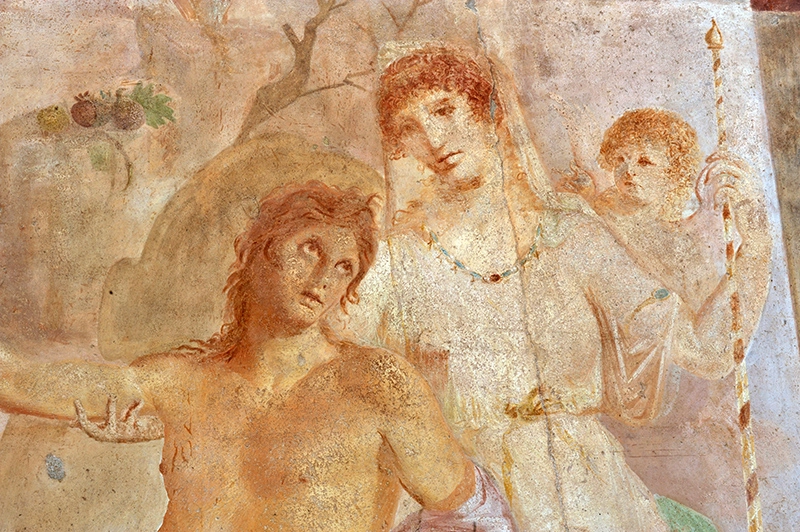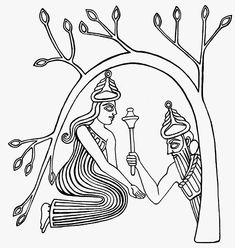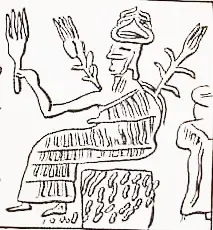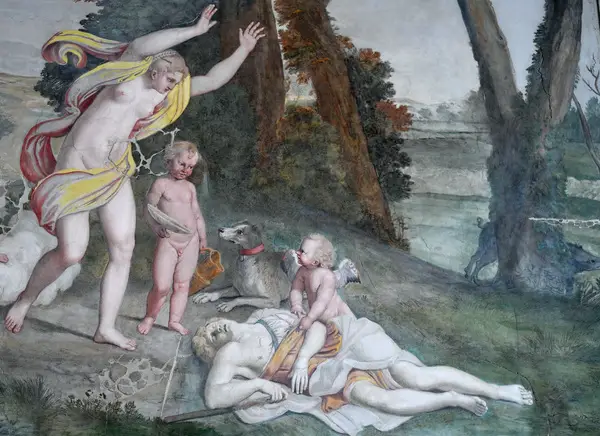The use of the on nenniri in Sardinia survives despite its scars and, whether it is a form of vital culture or a residue, it deserves our attention because we are faced with a use as ancient as mankind: one of those gestures that women and men of yesterday they were convinced they could cyclically restore order by rescuing the world from Chaos.
di Claudia Zedda
Article originally published on Author's blog.
Review by Marco Maculotti.
Culture and its expressions are adaptive. The concept is rather trivial, but in itself it has something exciting: all are the result of a selection. The goal is your growth as an individual but above all the strengthening of the group. By bringing awareness to your gestures and those of your community, you could become aware of it and start selecting the cultural expressions that best suit you.
Cultural phenomena that do not serve the community for its survival simply disappear. In rare cases they remain in the form of fossils (cultural relics). They no longer evolve because they are dead uses, but they still have a function: to give security by offering an ephemeral idea of identity.
The use of the su nenniri (nènneri, nènneres, nènnari, nìnniri, erme, sipùlkru) in Sardinia it survives despite its scars and, whether it is a form of vital culture or a remnant, it deserves our attention because we are faced with a use as old as mankind: one of those gestures that yesterday's woman and man were convinced could cyclically restore order by subtracting the world from Chaos.

Il su nenniri Sardinian
Su nenniri it was a vase decorated with ribbons and colored flowers, containing small plants grown in the dark and therefore chlorotic, that is yellowish and sickly. It was prepared in two different periods: for the Sepulcher on Holy Thursday and/or for the party di St. John the Baptist. The seeds that began to germinate in the dark could be chickpeas, lentils, wheat, flax and according to the locality it was prepared seven, fifteen, twenty or forty days before the occasion. It was kept in the dark and warm and the earth in use had to be fat or cotton wool to always be kept moist. It appears that in some cases unspun flax tow and earth were used.
Suggested by the Christian tradition, the sardines kept on nenniri under the bed, inside a closed chest, under a basket or inside a wardrobe. The container, on the other hand, could have various natures: the plate and the split pumpkin are among the most common. The small garden decorated with fiori (roses, carnations, cineraria and more), flakes (red and/or blue) to clothes (red) could be taken to the church to be blessed or given (if prepared on the occasion of San Giovanni). In both cases the aim was to forge links with the deity and within the community.
The custom is linked to ancient pagan agricultural rites aimed at the cult of Earth understood as Mother: the practice symbolizes regeneration, death and rebirth, resurrection. The interesting thing is that on nenniri explains these concepts in pictures, using mythical thinking. The rebirth: indeed the germ and vegetation in general, unable to die, given its cyclical rebirth, lends itself well to representing the return of life. But it is not the only meaning explicated by nenniri.
Bonds: the garden ritualises the relationship between man and the divine (to which on nenniri is addressed) and with the community through the comaratic need comparative. These are bonds of support that go beyond friendship and beyond marriage. Indissoluble relationships, which tighten with the gift and acceptance of nenniri and subsequent leap into the fire. The Comparative is reminiscent of the ancient and mighty clan marriages which still today characterize matrilineal and gylanic societies.

The connection with Tammuz/Dumuzi, Adonis and Osiris
I didn't push my hand. We are really in the presence of an original use that gave birth to a real mythologem: that of Goddess o of the God who personifies the grain and who dies every year, condition sine qua non for the next rebirth. Dumuzi/Tammuz as well as Osiris are parents of "brilliant Dark Mothers". Periodically they die and their Goddesses, Inanna/Ishtar e Isis they periodically revive them. And seen that they play the game of the grain, which dies but then if a Goddess plants it, it is reborn, it is over that both have been associated with the grain.
We reasoned through images and through images the stories were told. The story of the reborn grain, for example, was staged with the beds of Osiris. It was about silhouettes sown with wheat, placed on the graves of young women and men. The germinating grain would have magically helped the deceased in the resurrection. Statuettes reproducing Osiris, made of clay, incense and wheat, were buried during sowing in the field with a variously elaborate ritual: it would have stimulated the "rebirth" of the wheat.
Tammuz it is still the tenth month of the Hebrew calendar (June/July) and the month of July of the Gregorian calendar in the Arabic language. To be clear, Tammuz still represents wheat today.
Whether I live or die, I am Osiris, I penetrate you and reappear through you. In you I perish and in you I grow.
The gods live in me because I live and grow in the grain that sustains them.


Tammuz will then become Adonis which fell into the cultural clutches of the Greeks will be changed into a young boy contested between two slightly less obscure but incredibly brilliant goddesses: Persephone and Afrodite. THE Adon, private celebrations celebrated by lovers and courtesans, will thus become viral. She was celebrated by creating and donating small gardens which, exposed to the sun's rays, quickly died (like the aforementioned Adonis) which were then thrown into the sea to celebrate the rebirth of the little God.
And since viral phenomena are liked, Christians — that their competitors have always observed them with great interest — they pilfer information here and there, also creating small gardens with two differences: they were prepared during the Easter season, the time of rebirth of their God, Christ, and they would no longer should have been left in the sun, but they should have been allowed to germinate in half-light, to represent the darkness of the sepulchre.
Even his name is curious. According to Aldo Domenico Atzei the term it would be related to the moon, which was called in Syria, Lebanon and Palestine Nenneru. The circle always leads back to the moon. I also point out that in Sardinian nenneria/innennériu it's a small, trivial thing, a trifle, and what lullaby it is nonsense.
Even the rarest is interesting herma/the sooner. The term herma translates into Italian as adonide, the flower of Adonis. Pliny the Elder said that i magi collected the first of the year to close it in a red canvas bag in order to ward off any fever and evil eye. The bag, the way we do pungas, would be worn or tied around the neck.

A female tradition
I have been unable to find cases of men preparing nenniri. This leads me to think that it was an exquisitely feminine use, as more ancient tradition suggests. In this regard, I report the use made of it in Ozieri.
Here the sowing of the grain was done on the day of Corpus Domini (or a few weeks before the feast) and took place in a cork container or generically vase. On St. John's Eveherma/s, dressed in a red and light blue cloth, he was placed at the window on a silk carpet; was positioned above it a doll with female features made of kneaded flour.
At night, a large fire was lit and the couples they intended to become appear and comare they stood one on one side and one on the other, holding each other by the right using a long stick (or handkerchief) to jump the fire. The use, which closely resembles that linked to the cult of Osiris, tightens the woman even more su nenniri considering that in traditional Sardinian society bread-making is the exclusive responsibility of women. It is also interesting that to be reborn in this case is a woman (female figure) and not a man.

Uses of on nenniri
Su nenniri , in itself a small miracle of rebirth told without the need to use even a word, was exhibited in the temple / church (both the Easter one and the one prepared for San Giovanni). Once consecrated it could be used for many purposes, including:
- propitiate a good harvest and protect from disease: in that case it was dispersed in the fields or among the cattle pens;
- simulate weddings;
- practice ritual healing: those in grain, used to decorate the Sepulcher of Christ on Holy Thursday, were taken home after the feast and used for fumigation which had religious, therapeutic and magical purposes. They were employed in the cure of various ills;
- practice rituals: in Bolotana, after being placed on the ground in front of the church, the young men on horseback went around him three times. He was then thrown to the ground. He does not escape the symbolism of the circle, of the rotation and of the offering of the earth to the Earth;
- make wishes: especially those prepared on the occasion of San Giovanni allowed to create a dialogue with the divine. If the woman who had prepared it obtained abundant germination she could deduce that she had the Saint's favor, with all that this favor could imply;
- build relationships comaratic and comparative: on the occasion of the San Giovanni cycle su nenniri adorned with carnations it could be offered to the person with whom you wanted to create this bond. In the event that the proposal is accepted, from su nenniri he would have picked himself a carnation. See, for example, the case of Quartu S. Elena where the comparatico remained in force until a few years before the start of World War II. It took place exclusively among women, who became comàri de fròris. The one who took the initiative sent su nenniri to the chosen friend, who, in case of acceptance, had to hurry to return it by placing a flower, usually a carnation. It also turns out that su nenniri used to tighten ties of this type was finally brought to the church and in front of the door shattered to the ground. Only then did we declare ourselves appear and comare. The fire leap perfected the birth of the new bond.
A Bari Sardo, in close proximity to the feast of St. John the Baptist takes place there festival of on nenniri. I nenniri of grain and legumes, decorated with ribbons, are thrown into the sea as in use for the Adonies. Here su nenniri it is prepared in an earthenware pot, and is surmounted by a cane cross on which a crown bread and bunches of fruit are tied, enriched by many crosses of intertwined hay. The garden is carried in procession towards the sea on the head of a girl, flanked by two others, each of whom carries a freshly cut green reed: the two reeds are connected at the tops by a ribbon, to form a sort of canopy; arrived at the sea, su nenniri it is carried in procession by boats, stripped of its ornaments and offered to the sea with a propitiatory intent.
A oliena, For the procession of the SS. Virgin which took place at Ferragosto, were displayed in the windows, embellished with multicolored ribbons, nenniri of wheat and legumes (from seeds put to germinate on August 1th) in order to propitiate the rain, or they were brought to the church at the foot of the simulacrum of the Madonna.

Symbolic elements of on nenniri
The recurring elements are the land, germ, node and they are powerful symbols. If much has been said about the earth and wheat, it now deserves some further study the element node which symbolically represents a bond or blockage of energies and forces. The knot is the magical tool that stops energies and crystallizes situations, used in a positive sense (stopping the state of health of a healthy person, making friendship or love relationships stable), but also in a negative sense (blocking and not only of those who receive the knot without their knowledge). In the case of su nenniri the knot is suggested:
- laid down by the presence of bows adorning the container, from the colored threads that bind the reeds in Barisardo;
- from the knot that in some cases the wives and cronies make to the handkerchief: held by both by an edge, it joins the two while they are jumping over the fire to establish the bond;
- the knot is also and above all suggested by the function di su nenniri which once donated and accepted creates a indissoluble bond with the divine (if donated to church) or with the human (if donated to create comaratico or comparatico). The bond created between wives and cronies has nothing to do with the creation of a love/marriage relationship: wives and cronies can be of the same sex or of different sexes. The relevant thing is that it is a bond that sanctions the deep and supportive union between two people and families. In short, as already mentioned above, a real marriage between those who once must have been clans into which the community was divided;
- the ritual is worthy of attention: it tells of a society capable of creating stable relationships for survival. It also highlights Sardinian women's emancipation: women who had a companion could undoubtedly also have a husband. The two ties could not and should not conflict.
That su nenniri form a truly mutually supportive bond resembling today's marriage as evidenced by its breaking at the church door. Something very similar happens in the celebration of the marriage ritual. The mother of the bride, before and after the celebration of the ecclesiastical wedding, breaks a plate full of flowers, wheat (not germinated), coins, salt and more. The gesture and the elements symbolize the good wishes addressed to the young couple. The rite in question is known as Sa Ditia. A Ditia special is celebrated on the occasion of the early death of a young woman and/or man. But that, as they say, is another story.
